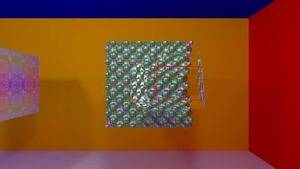Information
- Publication Type: Technical Report
- Workgroup(s)/Project(s):
- Date: April 2015
- Number: TR-186-2-15-02
- Keywords: optical flow, offline rendering, image reprojection, temporal upsampling, image-based rendering
Abstract
We introduce an image-based approach to increase the framerate of image sequences generated with offline rendering algorithms. Our method handles in most cases reflections and refractions better than existing image-based temporal coherence techniques. The proposed technique is also more accurate than some image-based upsampling methods, because it calculates an individual result for each pixel.Our proposed algorithm takes a pair of frames and generates motion vectors for each pixel. This allows for adding a new frame between that pair and thus increasing the framerate. To find the motion vectors, we utilize the non-local means denoising algorithm, which determines the similarity of two pixels by their surrounding and reinterpret that similarity as the likelihood of movement from one pixel to the other. This is similar to what it is done in video encoding to reduce file size, but in our case is done for each pixel individually instead of a block-wise approach, making our technique more accurate. Our method also improves on work in the field of real-time rendering. Such techniques use motion vectors, which are generated through knowledge about the movement of objects within the scene. This can lead to problems when the optical flow in an image sequence is not coherent with the objects movement. Our method avoids those problems. Furthermore, previous work has shown, that the non-local means algorithm can be optimized for parallel execution, which signicantly reduces the time to execute our proposed technique as well.
Additional Files and Images
Weblinks
No further information available.BibTeX
@techreport{ROEGNER-2015-IBR,
title = "Image-based Reprojection Using a Non-local Means Algorithm",
author = "Clemens R\"{o}gner and Michael Wimmer and Johannes Hanika
and Carsten Dachsbacher",
year = "2015",
abstract = "We introduce an image-based approach to increase the
framerate of image sequences generated with offline
rendering algorithms. Our method handles in most cases
reflections and refractions better than existing image-based
temporal coherence techniques. The proposed technique is
also more accurate than some image-based upsampling methods,
because it calculates an individual result for each pixel.
Our proposed algorithm takes a pair of frames and generates
motion vectors for each pixel. This allows for adding a new
frame between that pair and thus increasing the framerate.
To find the motion vectors, we utilize the non-local means
denoising algorithm, which determines the similarity of two
pixels by their surrounding and reinterpret that similarity
as the likelihood of movement from one pixel to the other.
This is similar to what it is done in video encoding to
reduce file size, but in our case is done for each pixel
individually instead of a block-wise approach, making our
technique more accurate. Our method also improves on work in
the field of real-time rendering. Such techniques use motion
vectors, which are generated through knowledge about the
movement of objects within the scene. This can lead to
problems when the optical flow in an image sequence is not
coherent with the objects movement. Our method avoids those
problems. Furthermore, previous work has shown, that the
non-local means algorithm can be optimized for parallel
execution, which signicantly reduces the time to execute our
proposed technique as well. ",
month = apr,
number = "TR-186-2-15-02",
address = "Favoritenstrasse 9-11/E193-02, A-1040 Vienna, Austria",
institution = "Institute of Computer Graphics and Algorithms, Vienna
University of Technology ",
note = "human contact: technical-report@cg.tuwien.ac.at",
keywords = "optical flow, offline rendering, image reprojection,
temporal upsampling, image-based rendering",
URL = "https://www.cg.tuwien.ac.at/research/publications/2015/ROEGNER-2015-IBR/",
}


 techreport
techreport
